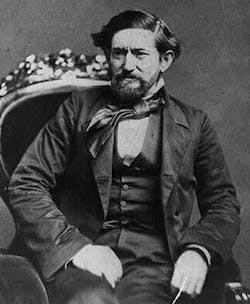Few organizations have the storied past of the Texas Rangers. The volumes of books (and not the dime store novels) proclaiming the exploits of the Rangers could fill a library. It is within this historic past that John Coffee "Jack" Hays became a captain and notable leader during a time of enormous turmoil in the west. Hays was a brilliant tactician and a remarkable leader, clearly demonstrated at the tender age of 23 when he was given the rank of Captain in the Rangers. Such a young command is nearly unheard of and speaks volumes about Jack Hays.
John Coffee Hays was born on January 28, 1817, at Little Cedar Lick in Wilson County, Tennessee. He grew up with an affinity for horseback riding and shooting. When he was fifteen his parents died of yellow fever; he, along with his brothers and sisters were sent away to live with relatives. Jack and two other siblings headed for Mississippi to a plantation. This didn't suit Jack's adventurous spirit well so he struck out on his own to become a surveyor. After two years and earning a bit of money Hays enrolled himself at the Davidson Academy in Nashville. Hearing of the battle at the Alamo, Hays set off to join the cause against the Mexican army. Enlisting in the Rangers and led by scout Deaf Smith, Hays settled in San Antonio.
While stationed in San Antonio, Hays acquired some land and began to resume his surveying activities. During this time he had contact with a Lipan Apache Chief named Flacco. The Chief taught Hays about differences in Indian fighting tactics and Hays would have numerous opportunities to use this knowledge against the fierce Commanche warriors. Flacco would later describe Hays after he charged into battle with pistol blazing and Flacco trying to keep up: "Me and Red Wing aren't afraid to go to hell together. Captain Jack, he's too mucho bravo. He's not afraid to go to hell all by himself." This was just another example of the fact that Hays always led from the front.
Hays was a forward thinking fighter who looked for an advantage on the battlefield. Usually outnumbered, Hays and his Rangers learned that firing and being able to reload their revolvers while on horseback could be used to devastating effect. In fact Hays was instrumental in the creation of the Colt six shooter. He and one is his officers, Samuel Hamilton Walker, had direct input in the design that was derived from the Colt Patterson No. 5, the same pistol the Rangers used so effectively. This new revolver was to become the Walker Colt. The new Colt fired a .44 caliber ball and held a charge twice that of the Patterson revolver.
Following the war with Mexico, Hays led a wagon train to California. His thirst for adventure and the lure of the gold rush led him to settle in San Francisco. He was elected Sheriff of San Francisco County in 1850 (at the grand old age of 33) and by all reports served the position well. After serving fours years as Sheriff Hays was appointed United States Surveyor General for the State of California in late 1853. Hays was one of the founders of the City of Oakland, eventually serving as the city's mayor. He amassed considerable wealth through real estate, ranching and utilities and was elected as a Delegate to the Democratic national convention in 1876 which nominated Samuel J. Tilden.
Hays passed away on April 21, 1883 and is buried in Mountain View Cemetery in Oakland. Hays County, Texas as well as Hays Consolidated High School are named in his honor.



